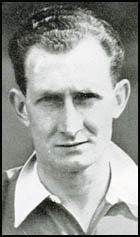Jack Crayston

Jack Crayston was born in Grange-over-Sands on 9th October 1910. A right-half he played for Ulverston Town before joining Barrow in 1928, who at the time was playing in the Third Division.
After playing 77 games for Barrow he joined Second Division side Bradford Park Avenue in 1930. Crayston developed a reputation as an outstanding defender. However, he suffered injury problems and broke his leg and wrist in the 1933-34 season.
In May 1934 George Allison, the manager of Arsenal, paid £5,250 for the talented Crayston. A non-smoker and teetotaller, Crayston joined a defence that included Frank Moss, Eddie Hapgood, George Male, Wilf Copping, Herbie Roberts and Bob John.
Crayston was a great success at Arsenal. He made his debut against Liverpool on 1st September 1934. and scored in the 8-1 victory. According to Jeff Harris, the author of Arsenal Who's Who, Cranston was "full of grace, an excellent ball player, strong in the tackle and brilliant in the air."
Crayston also became close friends with Wilf Copping. As Tom Whittaker pointed out in his autobiography, The Arsenal Story: "Although very dissimilar on and off the field, Crayston and Copping were inseparable. They trained together - that was another idea handed on by Chapman; he always insisted that a fast runner should train together with a slower mover, so as to help him increase his pace - and on all journeys were to be seen together, inevitably playing a peculiar form of Chinese whist."
Arsenal won the 1934-35 First Division league championship. Crayston played in 37 of the 42 games. Top scorer was Ted Drake who scored an amazing 42 goals in 41 games. This included three hat-tricks against Liverpool, Tottenham Hotspur and Leicester City and four, four-goal hauls, against Birmingham City, Chelsea, Wolves and Middlesbrough.
Crayston won his first international cap for England against Germany on 4th December 1935. England won the game 3-0. The England team that day included Cliff Bastin, Jackie Bray, George Camsell, Raich Carter, Eddie Hapgood, George Male, Stanley Matthews and Ray Westwood.
Arsenal finished in 6th place behind Sunderland in the 1935-36 season. A major factor in this was that Ted Drake was out of action for ten weeks with a serious knee injury. Arsenal did much better in the FA Cup that season. Arsenal beat Liverpool (2-0), Newcastle United (3-0), Barnsley (4-1) and Grimsby Town (1-0) to reach the final against Sheffield United. Drake, who was not fully fit, scored the only goal of the game.
Before the start of the 1937-38 season Herbie Roberts, Bob John and Alex James retired from football. Joe Hulme was out with a long-term back injury and Ray Bowden was sold to Newcastle United. However, a new group of younger players such as Bernard Joy, Alf Kirchen and Leslie Compton, became regulars in the side. George Hunt was also bought from Tottenham Hotspur to provide cover for Ted Drake who was still suffering from a knee injury. Cliff Bastin, Eddie Hapgood and George Male were now the only survivors of the team managed by Herbert Chapman.
Wolves were expected to be Arsenal's main rivals in the 1937-38 season. However, it was Brentford who led the table in February. They also beat Arsenal on 18th April, a game in which Ted Drake broke his wrist and suffered a bad head wound. However, it was the only two points they won during a eight game period and gradually dropped out of contention.
On the last day of the season Wolves were away to Sunderland. If Wolves won the game they would be champions, but they drew 1-1. Arsenal beat Bolton Wanderers at Highbury and won their fifth title in eight years. As a result of his many injuries, Ted Drake only played in 28 games but he still ended up the club's top scorer with 17 goals. Jack Crayston played in 31 league games that season and qualified for a second league championship medal.
Crayston won his eighth and last international cap for England against Czechoslovakia on 1st December 1937. Crayston scored one of the goals in England's 5-4 victory. The England team that day included Sam Barkas, Wilf Copping, Stan Cullis, Len Goulden, Willie Hall, Stanley Matthews, John Morton, Bert Sproston and Vic Woodley.
During the Second World War Cranston served in the Royal Air Force. However, he did manage to play in nearly a hundred friendly games until suffering a serious injury in December 1943.
In 1945 Crayston joined the Arsenal coaching staff and in June 1947 was appointed assistant manager to Tom Whittaker. After the death of Whittaker in November 1956 he became manager of the club. In his first season Arsenal finished in 5th place. However, the following season Arsenal slipped to 12th place, which was the club's lowest position for 38 years. In May 1958 Crayston resigned as manager.
In July 1958 Crayston was appointed manager of Doncaster Rovers in the Third Division. Unfortunately, the club finished in 22nd place in the 1958-59 season and was relegated. After spending two unsuccessful seasons in the Fourth Division he resigned as manager in March 1961.
Jack Crayston died aged 82 in December 1992.
Primary Sources
(1) Tom Whittaker, The Arsenal Story (1957)
Mr. Allison followed the signing of Drake by securing Jack Crayston, that elegant gentleman of the football field, and the tough, blue-chinned Wilf Copping. Although very dissimilar on and off the field, Crayston and Copping were inseparable. They trained together - that was another idea handed on by Chapman; he always insisted that a fast runner should train together with a slower mover, so as to help him increase his pace - and on all journeys were to be seen together, inevitably playing a peculiar form of Chinese whist. These three players were to win two First Division championship medals and a Cup winners' medal in the few years left before the war stopped competitive football.
